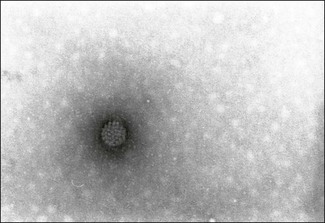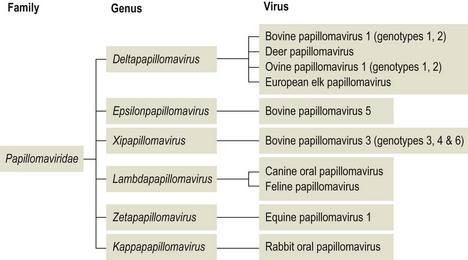Chapter 47 Members of the family Papillomaviridae are non-enveloped with icosahedral capsids (Fig. 47.1). Virions contain a single molecule of circular double-stranded DNA. The name is derived from the Latin papilla meaning nipple and the Greek suffix –oma used to form the names of tumours. The family originally contained a single genus, Papillomavirus, but now contains 16 genera (de Villiers et al. 2004; Fig. 47.2). There are proposals to increase the number of genera to 29 (Bernard et al. 2010). Papillomaviruses are 55 nm in diameter and replicate in the nucleus of host cells. The viruses are resistant to lipid solvents, acid and heating to 60°C for 30 minutes. Infections are typically persistent and are usually established early in life. In man several viral species and more than 80 genotypes are recognized while in cattle three species and 10 genotypes are known to exist. Individual types share less than 50% sequence homology and display differences when tested using reciprocal serological assays. Papillomaviruses are epitheliotropic, causing proliferative lesions termed papillomas or warts in epidermal or mucosal epithelia often at specific sites on the body. Papillomavirus infections occur in several animal species but only those occurring in cattle, horses and dogs are of significant veterinary importance (Table 47.1). Lesions are most commonly observed in young animals and usually regress spontaneously after a period of several weeks or months, with multiple warts regressing simultaneously. Regression is thought to be due to the development of cell-mediated immunity. In certain cases, in association with co-factors, the benign tumours induced by these viruses may progress to malignant neoplasms. Cultivation of papillomaviruses in cell culture is problematical but molecular biology techniques have made it possible to sequence several members and to detect their presence in lesions with great sensitivity. In infected cells the viral DNA usually remains episomal within the host cell nucleus. Papillomaviruses have been used in genetic engineering to insert foreign DNA into cultured cells. Table 47.1
Papillomaviridae
Virus
Host species
Disease
Bovine papillomavirus
types 1, 2
Cattle
Fibropapillomas of the head and neck of young cattle, sometimes affecting penis or teats. Implicated in the aetiology of sarcoids in horses. Type 2 has been implicated in neoplasms of bladder wall and enzootic haematuria
type 3
Persistent cutaneous papillomas
type 4
Upper alimentary tract papillomas capable of progression to malignancy in association with bracken fern ingestion
type 5
Teat fibropapilloma
type 6
Teat papilloma
type 7
Papillomas on skin and teats
type 8
Papillomas on teats and skin
types 9, 10
Papillomas on teats
Equine papillomavirus
Horse, donkey, mule
Papillomas of young horses
Canine oral papillomavirus
Dogs
Papillomas in oral cavity
Ovine papillomavirus types 1, 2
Sheep
Fibropapillomas
Cottontail rabbit papillomavirus (Shope’s papillomavirus)
Cottontail rabbits
Lesions appear as localized keratinized horns
Rabbit oral papillomavirus
Rabbit
Benign papillomas of oral cavity
Papillomaviridae
Only gold members can continue reading. Log In or Register to continue

Full access? Get Clinical Tree




